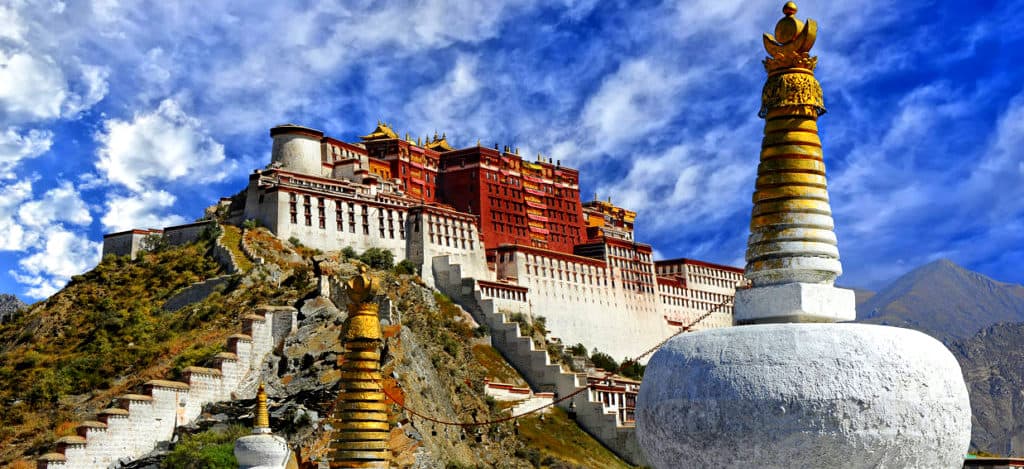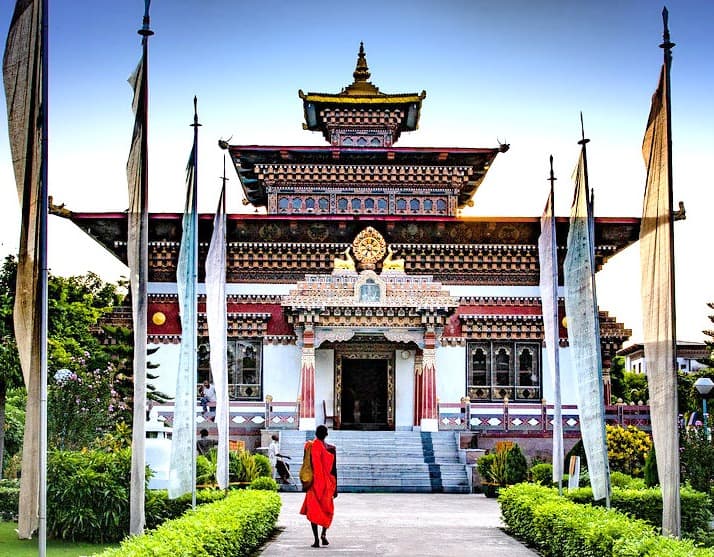Explore the Top 10 Best Places to Visit in Tibet to uncover a world of ancient culture and breathtaking landscapes. Nestled in the majestic Himalayas, Tibet offers a spiritual journey through its renowned destinations. From the sacred Lhasa, home to the iconic Potala Palace and revered Jokhang Temple, to the serene waters of Namtso Lake and Yamdrok Lake, each site resonates with tranquility and natural beauty. Embark on the Mount Everest Base Camp trek for an adventure of a lifetime, or delve into history at Gyantse with its historic fort and Pelkor Chode Monastery. Experience the intricate architecture of Tashilhunpo Monastery in Shigatse and explore the ancient murals of Sakya Monastery. Join a Mount Kailash pilgrimage to witness a convergence of faiths amidst unparalleled mountain vistas. Discover the best time to visit Lhasa to coincide with vibrant cultural festivals. Whether seeking spiritual enlightenment or adventure, Tibet promises an unforgettable journey into the heart of the Himalayas.
Druk Holidays welcomes you to embark on an unforgettable journey through Tibet's Top 10 best places, where every step reveals the soul-stirring beauty and profound cultural richness of the Roof of the World. As a leading tour operator specializing in the Himalayan region, we take pride in offering meticulously crafted experiences that showcase the essence of Tibet. From the awe-inspiring Potala Palace in Lhasa to the sacred Mount Kailash pilgrimage, each destination is meticulously selected to provide a deep dive into Tibet's spiritual and natural wonders. Our expert guides ensure you unravel the history of the Jokhang Temple, witness the serene beauty of Namtso Lake, and explore the ancient architecture of Tashilhunpo Monastery. With Druk Holidays, your journey to Tibet promises not just a vacation, but a transformative experience that connects you with the heart of this mystical land.
Potala Palace
The Potala Palace in Lhasa, Tibet, is an architectural marvel and a UNESCO World Heritage site, embodying the essence of Tibetan Buddhism and cultural heritage. Here are the highlights and key points of this iconic landmark:
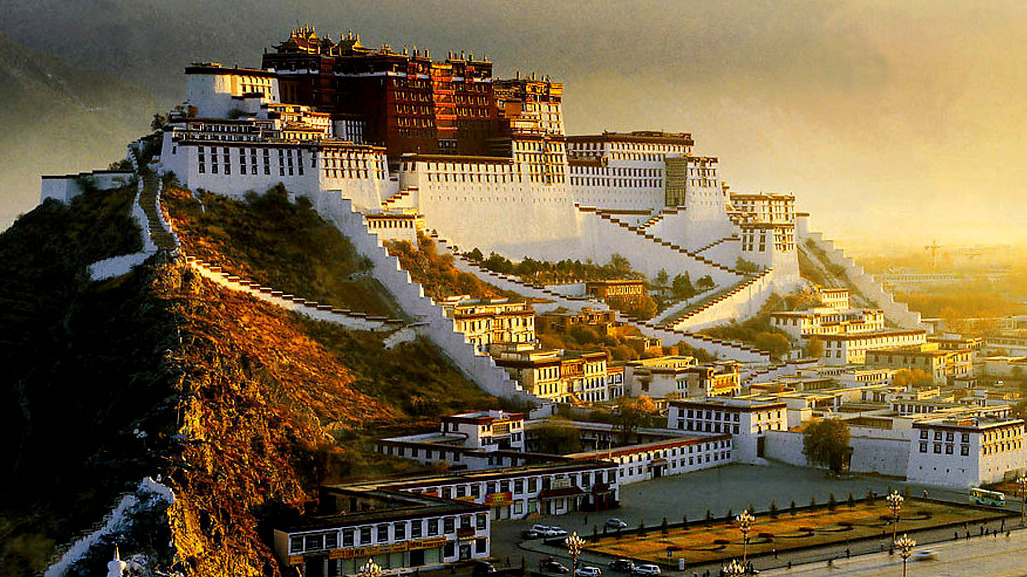
- History: Built initially in the 7th century by King Songtsen Gampo, the palace was expanded over centuries and served as the winter residence of the Dalai Lamas from the 17th century onwards.
- Architecture: The palace is renowned for its distinctive red and white colors, towering over Lhasa with its towering structure. It consists of the White Palace, used for administrative purposes, and the Red Palace, housing sacred chapels and stupas.
- Cultural Significance: Potala Palace is a spiritual hub with numerous chapels, halls, and rooms adorned with intricate murals, statues of Buddha, and other Tibetan Buddhist relics.
- Panoramic Views: Perched atop Marpo Ri (Red Hill), the palace offers breathtaking panoramic views of Lhasa city and the surrounding Himalayan mountains, providing a serene backdrop to its spiritual ambiance.
- Visitor Experience: Visitors can explore the palace's rich history, marvel at its architecture, and delve into Tibetan Buddhist history and traditions. Highlights include the Potala Palace ticket price and the opportunity to witness the Potala Palace history firsthand.
The Potala Palace is not just a historical site but a living testament to Tibet's cultural resilience and spiritual legacy, drawing pilgrims and tourists alike from around the globe to experience its profound beauty and significance.
Jokhang Temple
The Jokhang Temple, located in the heart of Lhasa's old town, is the most sacred temple in Tibet and a UNESCO World Heritage site. Here’s a detailed overview highlighting its significance and key features:

- Spiritual Center: The Jokhang Temple is revered as the spiritual heart of Tibetan Buddhism, attracting pilgrims from all corners of Tibet and beyond.
- Architecture: Built in the 7th century by King Songtsen Gampo, the temple combines Tibetan, Nepalese, and Indian architectural influences. Its golden roof and ornate facade are iconic symbols of Tibetan Buddhist architecture.
- Cultural Treasures: Within its walls, the temple houses numerous chapels adorned with ancient murals, statues of Buddha, and precious relics. The central hall enshrines the revered Jowo Shakyamuni statue, believed to be a likeness of Buddha at the age of 12.
- Pilgrimage Site: The Barkhor Square surrounding the temple is a bustling hub of religious activity, where pilgrims perform kora (circumambulation) around the temple complex, spinning prayer wheels and chanting mantras.
- Historical Significance: Throughout its history, the Jokhang Temple has survived wars and political changes, standing as a symbol of Tibetan identity and spiritual resilience.
Jokhang Temple offers not only a glimpse into Tibetan Buddhist history and culture but also a profound spiritual experience amidst the serene atmosphere of Lhasa’s ancient quarters. It remains a must-visit destination for those seeking to immerse themselves in Tibet’s rich spiritual heritage.
Mount Everest Base Camp
Mount Everest Base Camp in Tibet offers adventurers and nature enthusiasts an unparalleled experience at the foot of the world’s highest peak. Here’s an overview of this iconic destination:
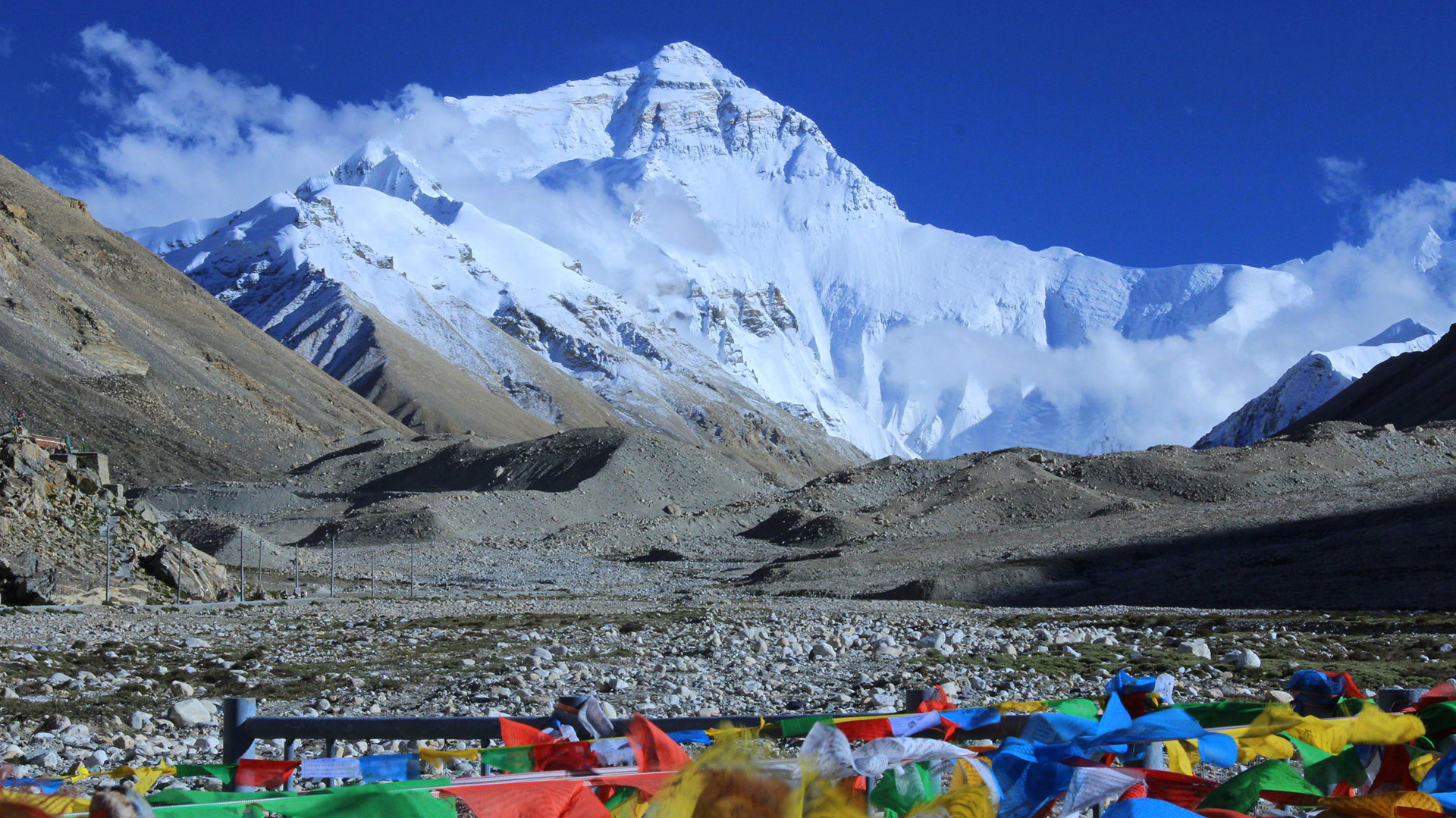
- Location: Situated on the northern side of Mount Everest, the Tibetan Base Camp provides breathtaking views of the towering Himalayan peaks.
- Adventure Trek: Trekking to Everest Base Camp is a challenging yet rewarding journey that allows visitors to witness the awe-inspiring beauty of the Himalayas up close.
- Altitude: At an altitude of approximately 5,200 meters (17,060 feet), the base camp serves as a starting point for climbers preparing to ascend Mount Everest from the Tibetan side.
- Scenic Views: Visitors can enjoy panoramic views of Mount Everest and nearby peaks like Lhotse and Cho Oyu, as well as the vast Tibetan plateau stretching below.
- Cultural Insight: The journey to Everest Base Camp also offers insights into local Tibetan culture, as travelers pass through traditional villages and encounter the warm hospitality of the Tibetan people.
- Logistics: Travelers can reach Everest Base Camp by road from Lhasa, typically as part of organized tours that include acclimatization stops to adjust to the high altitude safely.
Visiting Mount Everest Base Camp is a bucket-list experience for adventurers and nature lovers alike, providing a profound connection to one of the world’s most iconic natural wonders.
Namtso Lake
Namtso Lake, located in Tibet, is one of the most sacred and stunning lakes in the region, renowned for its natural beauty and spiritual significance. Here’s an insightful overview of this remarkable destination:
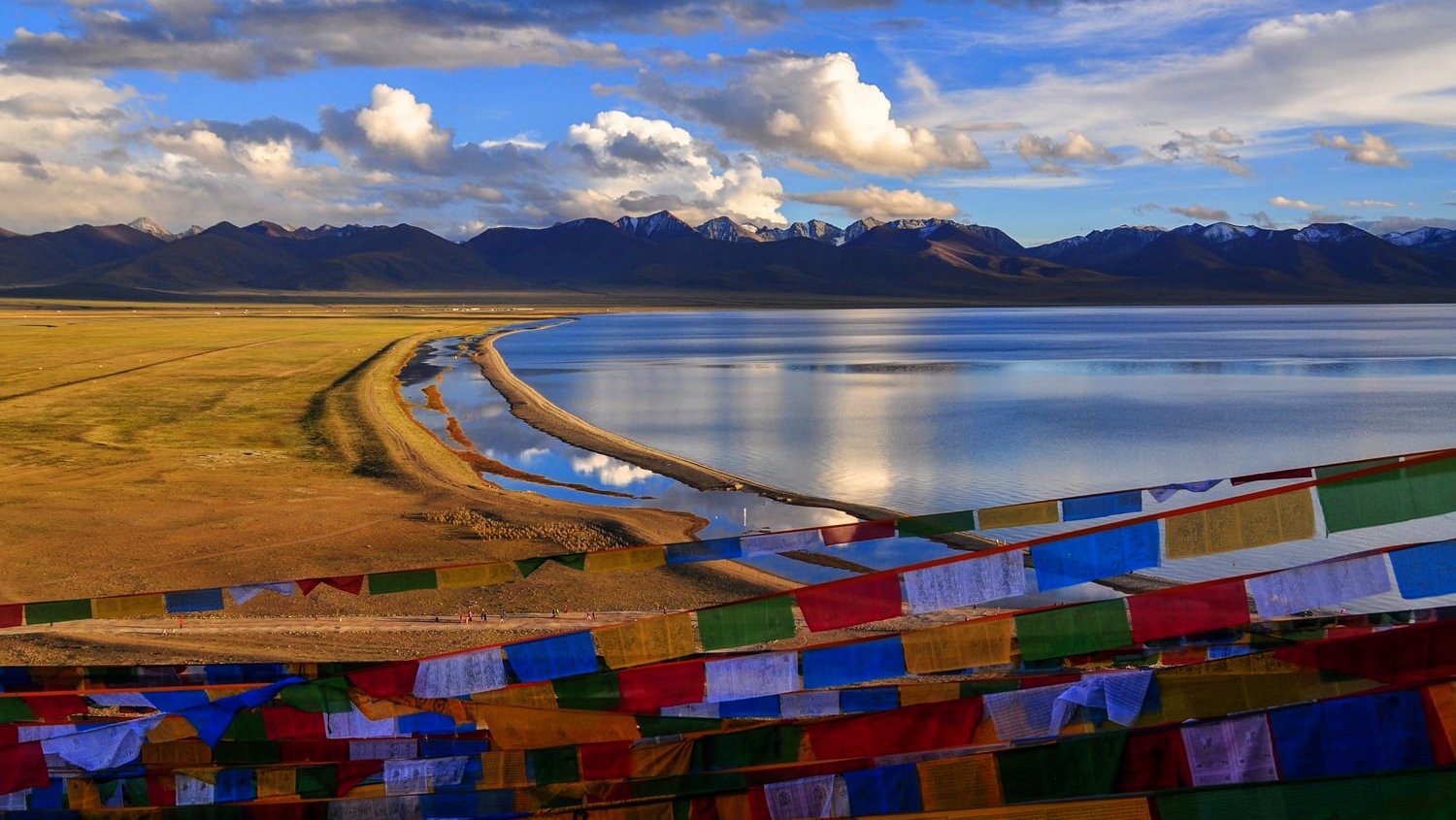
- Sacred Lake: Namtso Lake is considered one of Tibet's three holy lakes, revered by Tibetan Buddhists as a place of spiritual pilgrimage.
- Natural Beauty: Nestled amidst snow-capped mountains on the Tibetan Plateau, Namtso captivates visitors with its pristine, turquoise-blue waters and surrounding high-altitude landscape.
- Altitude: At an elevation of approximately 4,718 meters (15,479 feet), Namtso Lake is one of the highest-altitude saltwater lakes in the world, adding to its allure and serenity.
- Photography: Photographers flock to Namtso to capture its breathtaking vistas, especially during sunrise and sunset when the changing light paints the lake and its surroundings with mesmerizing colors.
- Wildlife: The lake and its shores are home to a variety of wildlife, including migratory birds, Tibetan gazelles, and occasionally, wild yaks, offering opportunities for nature enthusiasts and photographers.
- Pilgrimage: Pilgrims often perform kora (circumambulation) around the lake, a spiritual practice that involves walking along its shores and visiting nearby hermitages and monasteries.
- Accessibility: Namtso Lake is accessible from Lhasa by road, making it a popular destination for day trips or overnight stays in nearby tent camps, where visitors can experience the tranquil beauty of the lake under the vast Tibetan sky.
The Lake provides not only a chance to appreciate its natural splendor but also a profound encounter with Tibetan spirituality and the unique ecosystem of the Tibetan Plateau.
Yamdrok Lake
Yamdrok Lake is a mesmerizing freshwater lake located in Tibet, renowned for its turquoise waters and stunning mountain backdrop. Here’s a detailed overview of this picturesque destination:
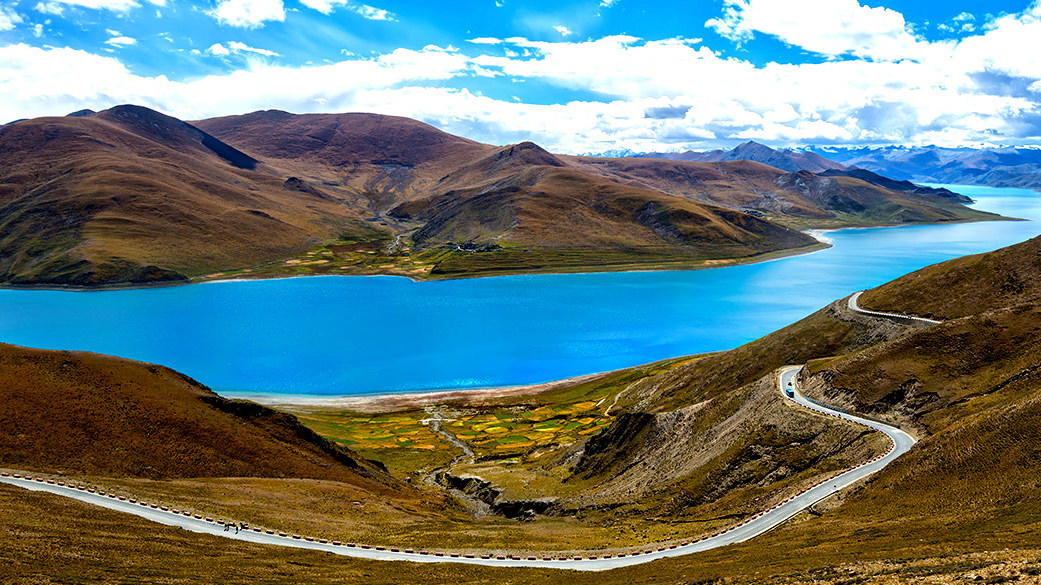
- Natural Beauty: Yamdrok Lake captivates visitors with its deep turquoise-blue waters, set against the backdrop of snow-capped mountains and an expansive Tibetan plateau.
- Altitude: Situated at an altitude of approximately 4,441 meters (14,570 feet), Yamdrok Lake is one of the highest freshwater lakes in the world, adding to its pristine beauty and serene atmosphere.
- Scenic Views: The lake offers breathtaking panoramic views, making it a favorite spot for photographers and nature enthusiasts seeking to capture the changing hues of the water under the vast Tibetan sky.
- Cultural Significance: Yamdrok Lake holds significant spiritual importance for Tibetans, believed to be a sacred lake associated with protective deities and revered as a part of the pilgrimage circuit in Tibet.
- Accessibility: Visitors can reach Yamdrok Lake from Lhasa by road, enjoying a scenic drive through rugged landscapes and traditional Tibetan villages.
- Outdoor Activities: The lake area is ideal for leisurely walks along its shores, picnicking, and enjoying the serene natural environment. Local nomadic communities also offer insights into traditional Tibetan life and culture.
- Environmental Conservation: Efforts are underway to preserve the pristine ecosystem of Yamdrok Lake and protect its unique flora and fauna, including migratory birds and endemic species.
Yamdrok Lake promises a tranquil escape into nature’s beauty, combined with a glimpse into Tibetan spirituality and culture, making it a must-visit destination for travelers to Tibet.
Gyantse
Gyantse, a historic town in Tibet, offers a glimpse into the region's rich cultural heritage and ancient architectural marvels. Here’s an overview highlighting the essence of Gyantse:

- Historic Fort: Gyantse is renowned for its historic fort, strategically perched atop a hill, offering panoramic views of the surrounding valleys and mountains. The fort reflects Gyantse's historical importance as a major trading hub along the ancient trade routes of Tibet.
- Pelkor Chode Monastery: One of Gyantse's most iconic landmarks is the Pelkor Chode Monastery, famed for its Kumbum Stupa, a unique structure with nine levels and countless chapels filled with exquisite murals and Buddhist sculptures. It stands as a testament to Tibetan art and architecture.
- Cultural Crossroads: Gyantse town itself exudes a blend of Tibetan and Han Chinese influences, evident in its architecture, cuisine, and cultural practices. Visitors can explore local markets, interact with friendly locals, and delve into the town’s vibrant history.
- Gateway to Mount Kailash: Gyantse serves as a gateway for travelers embarking on the sacred pilgrimage to Mount Kailash and Lake Manasarovar, offering essential amenities and a cultural introduction before the journey into the remote western Tibetan plateau.
- Community Life: Beyond its historical and architectural treasures, Gyantse provides insights into traditional Tibetan community life, where nomadic herders and farmers maintain their ancestral way of life amidst stunning natural landscapes.
- Accessibility: Located along the popular tourist route between Lhasa and Shigatse, Gyantse is easily accessible by road, making it a convenient stop for travelers exploring central Tibet.
Exploring the Gyantse allows travelers to step back in time and immerse themselves in Tibet’s cultural tapestry, from ancient fortresses to vibrant monasteries, all set against the backdrop of majestic Himalayan scenery.
Tashilhunpo Monastery
Tashilhunpo Monastery, located in Shigatse, Tibet, is one of the region's most significant religious and cultural sites. Here’s an overview highlighting its importance and attractions:
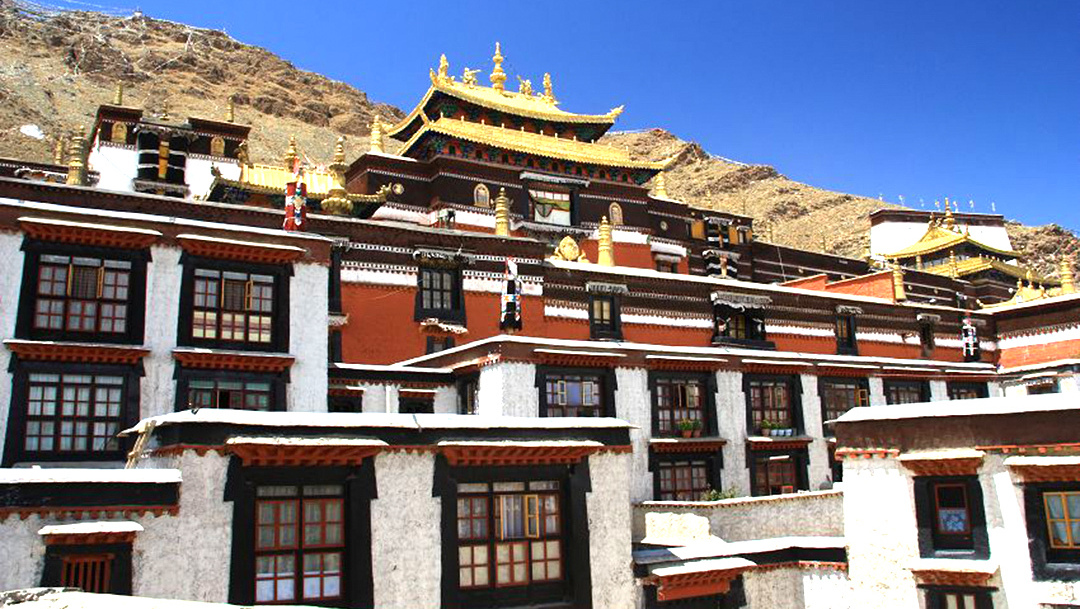
- Historical Significance: Founded in 1447 by the first Dalai Lama, Gedun Drub, Tashilhunpo Monastery has served as the traditional seat of the Panchen Lama, the second highest spiritual leader in Tibetan Buddhism after the Dalai Lama.
- Architectural Grandeur: The monastery is renowned for its impressive architecture, characterized by towering white walls, golden roofs, and intricate Tibetan motifs. Visitors can explore its numerous chapels, assembly halls, and living quarters, each adorned with ancient murals, statues of Buddhist deities, and Tashilhunpo Monastery artifacts.
- Spiritual Center: Tashilhunpo remains an active center of Tibetan Buddhism, where monks engage in daily rituals, prayers, and religious study. The grand Maitreya Buddha statue, standing over 26 meters tall and gilded with gold, is a highlight of the monastery and a focal point for pilgrims.
- Cultural Experience: Beyond its religious significance, Tashilhunpo offers visitors a glimpse into Tibetan culture and history. The monastery hosts traditional festivals and ceremonies throughout the year, providing opportunities to witness vibrant Buddhist rituals and ceremonies.
- Visitor Experience: Travelers to Tashilhunpo Monastery can participate in guided tours to learn about its history, architecture, and religious practices. The nearby town of Shigatse also offers accommodations and amenities for visitors exploring this cultural gem of Tibet.
This amazing Monastery offers not only a deep dive into Tibetan Buddhism but also a chance to admire its artistic splendor and experience the spiritual ambiance that has enchanted pilgrims and travelers for centuries.
Sakya Monastery
Sakya Monastery, situated in Sakya County of Tibet, is a significant religious and cultural landmark renowned for its unique architecture and historical importance. Here’s an overview highlighting the key aspects of Sakya Monastery:
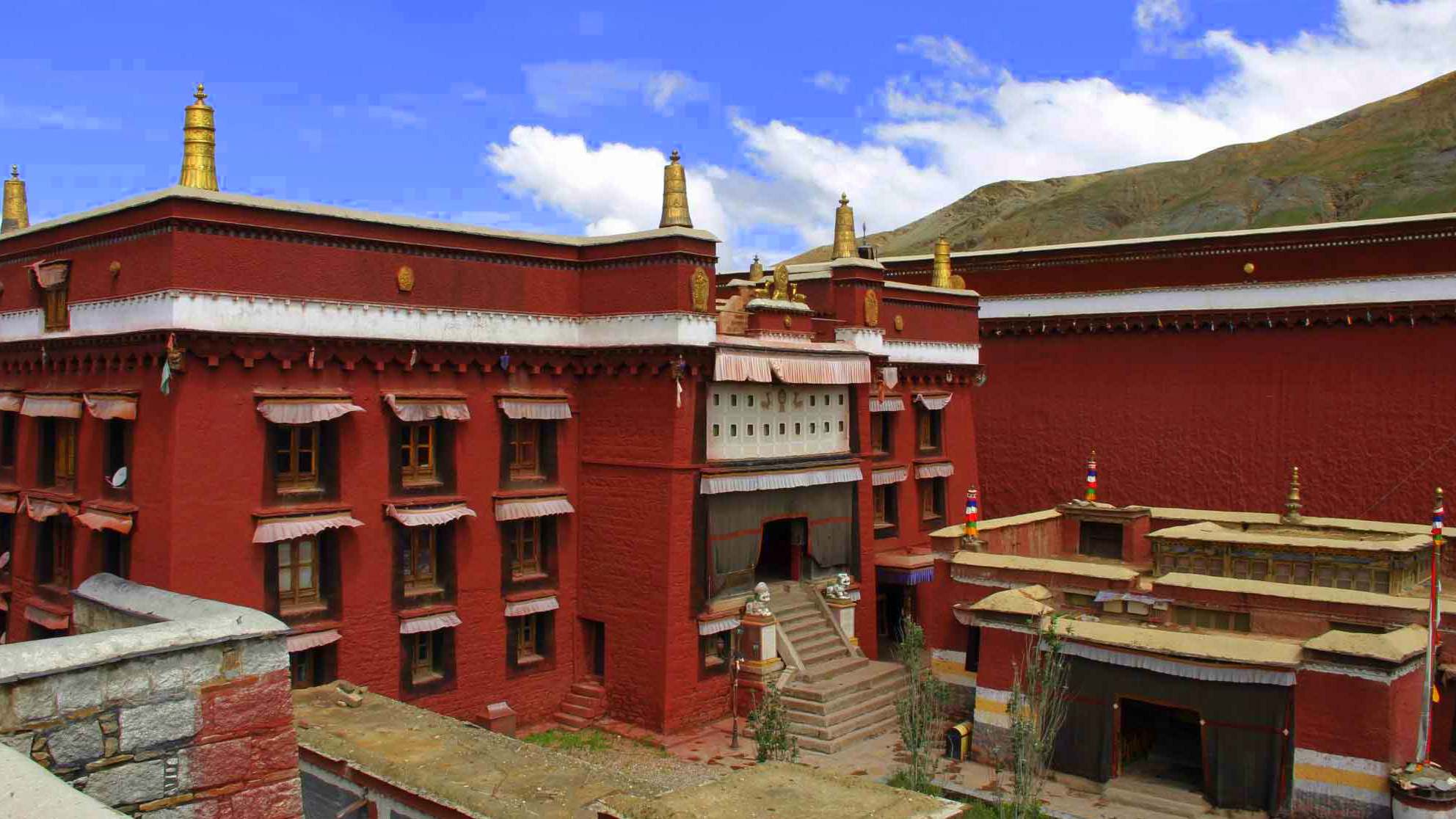
- Distinctive Architecture: Sakya Monastery is characterized by its distinctive Mongolian architectural style, with its massive walls and watchtowers built to withstand the region's harsh climate. The monastery's red, white, and gray color scheme symbolizes the union of wisdom and compassion in Tibetan Buddhism.
- Historical Significance: Founded in the 11th century, Sakya Monastery has played a crucial role in Tibetan religious and political history. It served as the seat of the Sakya school of Tibetan Buddhism, which exerted significant influence during the Yuan and Ming dynasties in China.
- Cultural Treasures: The monastery houses a wealth of cultural treasures, including ancient scriptures, thangka paintings, and intricate murals depicting Buddhist teachings and historical events. Visitors can admire these artifacts, gaining insights into Tibetan art and religious practices.
- Visitor Experience: Guided tours of Sakya Monastery provide visitors with opportunities to explore its various chapels, prayer halls, and monk quarters. The monastery's serene ambiance and spiritual aura offer a peaceful retreat for meditation and contemplation.
- Local Community: Surrounding the monastery, the town of Sakya offers a glimpse into traditional Tibetan life, where local residents continue to uphold their cultural heritage through farming, crafts, and traditional festivals.
- Accessibility: Sakya Monastery is accessible from Shigatse and other major Tibetan cities by road, making it a convenient stop for travelers exploring the region's cultural and religious sites.
Sakya Monastery allows travelers to immerse themselves in the rich history and spiritual essence of Tibetan Buddhism, experiencing firsthand the architectural grandeur and cultural legacy of this ancient monastery.
Mount Kailash
Mount Kailash, located in western Tibet, is revered as a sacred peak by Hindus, Buddhists, Jains, and Bonpos alike, drawing pilgrims from around the world for its spiritual significance and breathtaking natural beauty. Here’s an overview highlighting the essence of Mount Kailash:
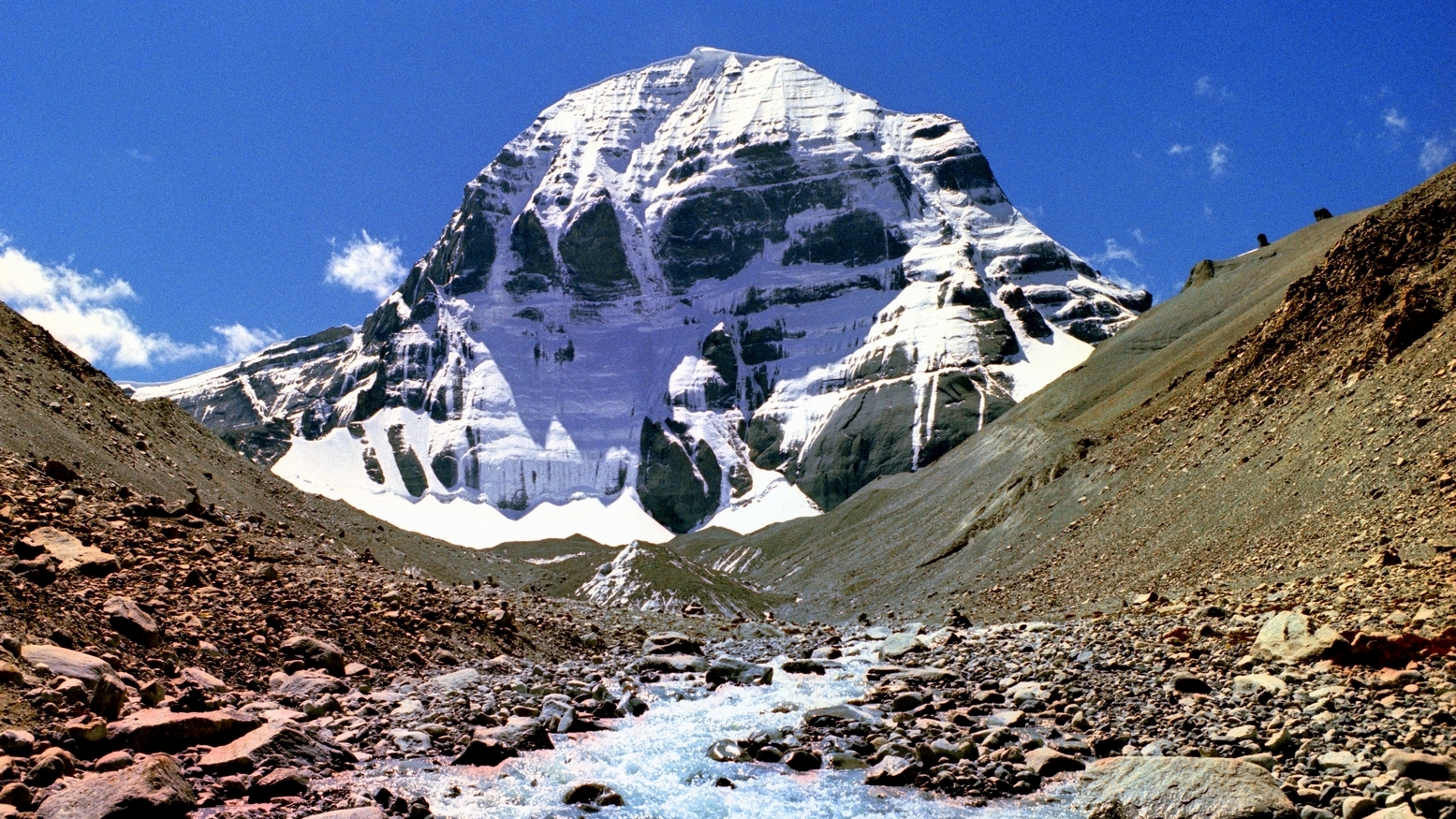
- Spiritual Significance: Mount Kailash is believed to be the abode of Lord Shiva by Hindus, a representation of enlightenment and spiritual liberation for Buddhists, and a sacred site associated with spiritual awakening for Jains and Bonpos. The circumambulation or Mount Kailash pilgrimage around the mountain, known as the Mount Kailash trek difficulty, is considered a sacred ritual that cleanses sins and leads to spiritual enlightenment.
- Natural Beauty: The peak rises majestically to an altitude of 6,638 meters (21,778 feet), standing as a solitary pyramid-shaped mountain amidst the vast Tibetan plateau. Its snow-capped summit and rugged terrain create a dramatic backdrop against the clear blue skies.
- Cultural Rituals: Pilgrims embark on the Mount Kailash inner kora, a trek that involves circumambulating the mountain on foot, covering a distance of approximately 52 kilometers. The journey includes stops at significant sites such as Mount Kailash accommodation, Mount Kailash weather, and the sacred Mount Kailash pilgrimage.
- Logistics: Access to Mount Kailash is primarily through Mount Kailash tours from Lhasa, with travel requiring careful planning due to high-altitude conditions and remote terrain. Mount Kailash trek difficulty varies depending on the route chosen, with options for both Mount Kailash inner kora and outer kora.
Mount Kailash offers not only a profound spiritual experience but also a chance to immerse oneself in the natural splendor of the Tibetan plateau, making it a destination of choice for adventurers and seekers of spiritual enlightenment alike.
Barkhor Street
Barkhor Street, located in the heart of Lhasa's old town, is a bustling marketplace and pilgrimage circuit that encapsulates the essence of Tibetan culture and spirituality. Here’s an overview highlighting the significance and attractions of Barkhor Street:
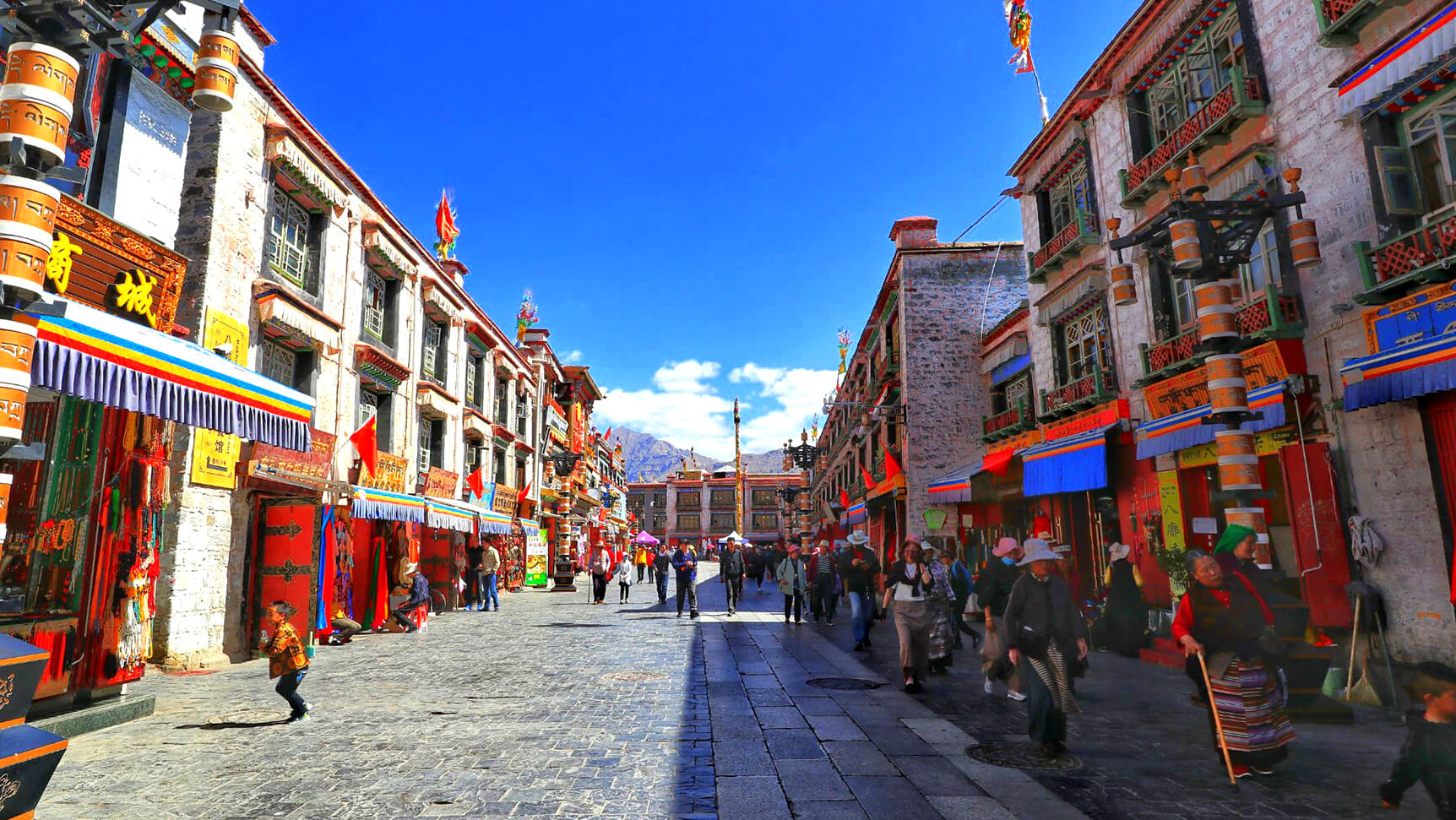
- Pilgrimage Circuit: Barkhor Street is a sacred kora (circumambulation) path around the Jokhang Temple, making it a focal point for Tibetan Buddhist pilgrims who walk clockwise around the temple complex, spinning prayer wheels and reciting mantras.
- Cultural Hub: The street is lined with traditional Tibetan houses, shops, and stalls selling a variety of goods such as Tibetan handicrafts, Barkhor Street restaurants, Barkhor Street hotels, and Barkhor Street shops, offering visitors an opportunity to experience authentic Tibetan cuisine and Tibetan culture.
- Historical Significance: Barkhor Street has served as a vibrant commercial center and Barkhor Street market since ancient times, facilitating trade along the Barkhor Street Lhasa route between India, Nepal, and Central Asia. Today, it remains a place where old meets new, with modern shops and cafes coexisting alongside traditional Tibetan teahouses and religious artifacts.
- Community Life: Beyond its religious and commercial significance, Barkhor Street offers insights into local Tibetan community life, where residents gather for Barkhor Street festival, cultural events, and daily activities. Visitors can interact with friendly locals and learn about their customs and traditions.
- Accessibility: Located within walking distance of major landmarks such as the Potala Palace, Jokhang Temple, and Barkhor Street Jokhang Temple, Barkhor Street is easily accessible from hotels and guesthouses in Lhasa, making it a popular destination for tourists exploring the rich Barkhor Street attractions and history of Tibet.
Exploring Barkhor Street provides travelers with a unique opportunity to immerse themselves in the vibrant tapestry of Tibetan culture, history, and spirituality, making it an essential stop on any visit to Lhasa.
Important things to consider while visiting these places
When visiting the top places in Tibet, there are several important considerations to ensure a safe, respectful, and enjoyable trip. Here are some key points to keep in mind:
Altitude Sickness
- Acclimatization: Give yourself time to acclimatize to high altitudes, especially in Lhasa and other high-elevation areas.
- Hydration: Drink plenty of water to stay hydrated.
- Medication: Consider carrying altitude sickness medication and consult with a healthcare professional before your trip.
Travel Permits
- Tibet Travel Permit: All foreign travelers need a Tibet Travel Permit, which must be obtained through a registered travel agency.
- Additional Permits: Depending on your itinerary, additional permits such as the Aliens’ Travel Permit and the Military Permit might be required for certain regions.
Cultural Sensitivity
- Respect Local Customs: Be mindful of local customs and traditions. Dress modestly and behave respectfully at religious sites.
- Photography: Always ask for permission before taking photos of people, especially monks and locals in religious settings.
- Temple Etiquette: Follow proper etiquette when visiting temples and monasteries, such as walking clockwise around religious structures and removing hats and sunglasses inside sacred places.
Environmental Responsibility
- Leave No Trace: Practice responsible tourism by not littering and minimizing your environmental impact.
- Wildlife: Respect wildlife and natural habitats; do not disturb animals or their environment.
Health and Safety
- Medical Kit: Carry a basic medical kit with essentials like band-aids, antiseptics, pain relievers, and any personal medications.
- Insurance: Make sure you have comprehensive travel insurance that covers medical emergencies, evacuations, and trip cancellations.
Weather and Clothing
- Layering: The weather in Tibet can be unpredictable, so pack clothing that can be layered to adapt to varying temperatures.
- Sun Protection: At high altitudes, the sun’s UV rays are stronger. Use sunscreen, wear sunglasses, and a wide-brimmed hat.
Local Cuisine
- Dietary Restrictions: Inform your travel agency or guides of any dietary restrictions. Tibetan cuisine can be quite different from what you’re used to.
- Hydration: Avoid drinking tap water; use bottled or purified water for drinking and brushing your teeth.
Communication
- Language: Learning a few basic phrases in Tibetan or Mandarin can be very helpful and appreciated by locals.
- Connectivity: Be prepared for limited internet and phone connectivity in remote areas.
Money
- Cash: ATMs may not be available in remote areas, so carry enough cash for your expenses.
- Currency: The official currency is the Chinese Yuan (CNY). Make sure to have small denominations for convenience.
Transportation
- Travel Agency: Work with a reliable travel agency like Druk Holidays to ensure smooth logistics and compliance with local regulations.
- Transport Options: Understand the local transportation options, including taxis, buses, and private vehicles arranged by your travel agency.
By considering these factors, you’ll be well-prepared to enjoy the stunning landscapes, rich culture, and spiritual ambiance of Tibet’s top destinations safely and respectfully.
Exploring Tibet's Top 10 best places is a journey into the heart of a land steeped in spirituality, culture, and natural beauty. From the majestic Potala Palace and sacred Jokhang Temple in Lhasa, to the serene waters of Namtso Lake and Yamdrok Lake, each destination offers a unique blend of historical richness and breathtaking landscapes. Embarking on the adventurous Mount Everest Base Camp trek or experiencing the profound spiritual significance of Mount Kailash pilgrimage provides unforgettable insights into Tibetan traditions and beliefs. Whether marveling at the architectural splendor of Tashilhunpo Monastery in Shigatse, exploring the ancient history of Gyantse, or discovering the cultural treasures of Sakya Monastery, Tibet captivates with its spiritual allure and natural wonders. Plan your journey wisely to witness these extraordinary sites and immerse yourself in the mystique of the Roof of the World.
FAQs for the Top 10 Best Places to Visit in Tibet
Q: What is the best time to visit Tibet?
A: The best time to visit Tibet is from April to October, during the region's dry season when the weather is most favorable for travel.
Q: How can I visit Mount Everest Base Camp from Lhasa?
A: Travelers can reach Mount Everest Base Camp from Lhasa by road, typically as part of organized tours that include stops at various scenic spots and acclimatization breaks to adjust to the high altitude.
Q: What is the altitude of Namtso Lake and Yamdrok Lake?
A: Namtso Lake is situated at an altitude of approximately 4,718 meters (15,479 feet), while Yamdrok Lake is at around 4,441 meters (14,570 feet) above sea level.
Q: What are the highlights of visiting Potala Palace?
A: Potala Palace, located in Lhasa, is renowned for its historical significance as the former winter residence of the Dalai Lamas, its striking architecture, and panoramic views of Lhasa city.
Q: Can I trek to Mount Kailash? How difficult is the Mount Kailash trek?
A: Yes, travelers can embark on the Mount Kailash trek, which includes the Mount Kailash inner kora and outer kora. The trek is considered challenging due to high altitudes and varying terrain, requiring good physical fitness and acclimatization.
Q: What is special about Tashilhunpo Monastery in Shigatse?
A: Tashilhunpo Monastery is notable for its grandeur as the traditional seat of the Panchen Lama, its towering Maitreya Buddha statue, and its rich collection of Tibetan Buddhist artifacts and Tashilhunpo Monastery architecture.
Q: How can I explore Barkhor Street in Lhasa?
: Barkhor Street is accessible on foot from major landmarks such as Potala Palace and Jokhang Temple, offering visitors a chance to stroll through a bustling marketplace, spin prayer wheels, and witness daily Tibetan life and Barkhor Street festival.
Q: What are the cultural attractions in Gyantse?
A: Gyantse boasts historical attractions like its fort, which offers panoramic views, and Pelkor Chode Monastery with its unique Kumbum Stupa, showcasing Tibetan Buddhist art and Gyantse fort history.
Q: How do I plan a pilgrimage to Mount Kailash?
A: Planning a pilgrimage to Mount Kailash involves coordinating travel logistics, obtaining necessary permits, and preparing for the Mount Kailash trek difficulty and high-altitude conditions. It's advisable to join organized Mount Kailash pilgrimage tours that cater to spiritual and logistical needs.
Q: What should I know about visiting Namtso Lake?
A: Namtso Lake is a stunning high-altitude lake known for its crystal-clear waters and surrounding snow-capped mountains. It's essential to be prepared for cold temperatures and high altitudes. Photography enthusiasts will find plenty of opportunities for breathtaking shots.

